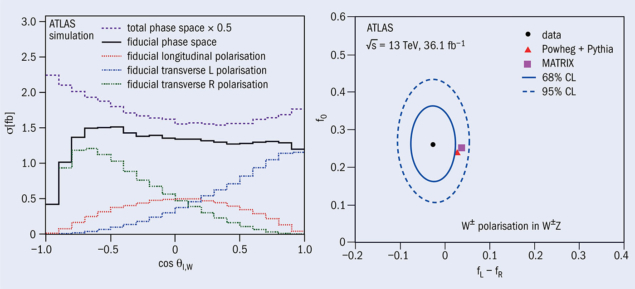A report from the ATLAS experiment
Precision measurements of diboson processes at the LHC are powerful probes of the gauge structure of the Standard Model at the multi-TeV energy scale. Among the most interesting directions in the diboson physics programme is the study of gauge-boson polarisation. The existence of three polarisation states is predicted by the Standard Model. The transverse polarisation is composed of right- and left-handed states, with spin either parallel or antiparallel to the momentum vector of the boson. The third state, a longitudinally-polarised component, is generated when the W and Z bosons acquire mass through electroweak symmetry breaking, and is therefore under particular scrutiny.
New phenomena can alter the polarisation predicted by the Standard Model due to interference between new-physics amplitudes and diagrams with gauge-boson self-interactions. WZ production, with its clean experimental signature, offers a sensitive way to search for such anomalies by providing a direct probe of the WWZ gauge coupling, due to the s-channel “Z-strahlung” contribution, where the W radiates a Z.
Building on precision WZ measurements previously reported by the ATLAS and CMS collaborations, a recent ATLAS result constitutes the most precise WZ measurement at a centre-of-mass energy of 13 TeV, and provides the first measurement of the polarisation of pair-produced vector bosons in hadron collisions. Based on 36.1 fb-1 of data collected in 2015 and 2016 by the ATLAS detector, and using leptonic decay modes of the gauge bosons to electrons or muons, ATLAS has achieved a precision of 4.5% for the WZ cross section measured in a fiducial phase space closely matching the detector acceptance. The kinematics of WZ events, including the underlying dynamics of accompanying hadronic jets, has been studied in detail by measuring the cross section as a function of several observables.

The polarisation states for W and Z bosons can be probed through distributions of the angle of the leptons relative to the bosons from which they decayed (figure 1, left). A binned profile-likelihood fit of templates describing the three helicity states allowed ATLAS to extract the W and Z polarisations in the fiducial measurement region. Because of the incomplete knowledge of the neutrino momentum originating from the W-boson decay, it is more difficult to measure the helicity fractions of the W than of the Z. The fraction of a longitudinally-polarised W boson in WZ events is found to be 0.26 ± 0.06 (figure 1, right), while the longitudinal fraction of the Z boson is found to be 0.24 ± 0.04. The analysis leads to an observed significance of 4.2 standard deviations for the presence of longitudinally-polarised W bosons, and 6.5 standard deviations for longitudinally-polarised Z bosons.
Improved precision
The measurements are dominated by statistical uncertainties, but future datasets will improve precision and allow the collaboration to probe new-physics effects in events where both the Z and the W are longitudinally polarised. The ultimate target is to measure the scattering of longitudinally polarised vector bosons: this would be a direct test of electroweak symmetry breaking.
Further reading
ATLAS Collaboration 2019 arXiv 1902.05759 (submitted to Eur. Phys. J. C).








